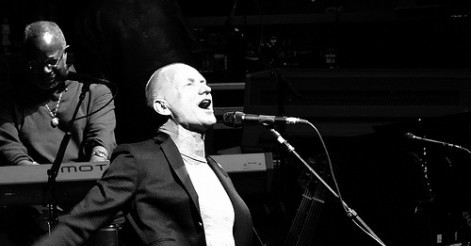
 )
)Following last week’s discussion of expertise (be sure to see the comments also) comes an entirely different perspective on the subject. Sting, formerly of The Police and more recently a genre-spanning solo musician, had his brain scanned while listening to a variety of music selections. The songs were grouped by the way Sting’s brain responded while hearing them. Other music comparison algorithms, like the one used by Pandora to recommend songs, rely on features of the music that are quantified in a more objective and explicit fashion and tend to include either genre or genre-specific qualities. Using Sting’s subjective reaction to the songs revealed connections that wouldn’t necessarily show up from other analyses because of the obvious dissimilarities. For example, Libertango by Astor Piazzola, instrumental dance music from Argentina, and Girl by The Beatles, a British folk rock song, were judged among the most similar pairs by Sting’s brain.
Having identified connections in an unconventional way, the researchers were still able to express the similarities between songs in basic musical language. The tunes shared features like tempo, key signature, melodic shape or rhythmic structure. Composer and educator Peter Schickele was comparing songs across genre barriers on these terms for years on his radio program Schickele Mix and in his classical mashups written for his alter ego P. D. Q. Bach. Still, most music conversation starts with genre categories, so there is some novelty to the pairings found by this study. And while Sting-in-an-fMRI is unlikely to power the next Spotify or Pandora, there might be something to learn from this work about how to create more eclectic music mixes.
I’d be particularly curious to know if Sting’s brain reacts differently from other listeners, and if those differences are explained by his experience as a performer and composer, his particular genre-blurring musical tastes, or just being Sting. Maybe everyone’s brain scans would create the same pairs because pitches and tempos are how brains process music, or maybe only a trained “ear” responds to those qualities. If experts of all stripes are set apart by a richer and more nuanced set of categories with which to understand their field, then being able to identify those categories and their boundaries would help make that expertise more concrete. And if those categories can be explained and shared readily with lay folk, then broader public conversations of expert topics might become more fruitful.
How many melodies can you identify in this Schickele composition?
Andy has worn many hats in his life. He knows this is a dreadfully clichéd notion, but since it is also literally true he uses it anyway. Among his current metaphorical hats: husband of one wife, father of two teenagers, reader of science fiction and science fact, enthusiast of contemporary symphonic music, and chief science officer. Previous metaphorical hats include: comp bio postdoc, molecular biology grad student, InterVarsity chapter president (that one came with a literal hat), music store clerk, house painter, and mosquito trapper. Among his more unique literal hats: British bobby, captain’s hats (of varying levels of authenticity) of several specific vessels, a deerstalker from 221B Baker St, and a railroad engineer’s cap. His monthly Science in Review is drawn from his weekly Science Corner posts — Wednesdays, 8am (Eastern) on the Emerging Scholars Network Blog. His book Faith across the Multiverse is available from Hendrickson.

Leave a Reply